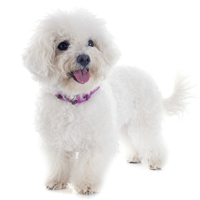
Major concerns: Patellar luxation
Occasionally seen: None
Average Size of Male: Height: 9.5 – 11.5 inches, Weight: 11 – 16 pounds
Average Size of Female: Height: 9.5 – 11.5 inches, Weight: 10 – 15 pounds
Suggested tests: Knee, eye
Life span: 12 – 15 years
Minor concerns: Tooth loss, cataract
Brief History on Bichon Frise Origin
Many suggest that the Bichon Frise was a result from the barbet or water spaniel, and perhaps the poodle somewhere along the line as well. It was from this history that some said the name “Barbichon” was derived, which was later shortened down to simply “Bichon.” It is said that the Bichons were separated into four specific divisions, including the the Bichon Bolognais, the Bichon Havanais, the Bichon Maltais, and the Bichon Teneriffe. All of which are said to have first originated somewhere in the Mediterranean region. History suggests that this breed was often used in bartering by sailors. These dogs were very popular in Spain, and its likeness can be found in paintings by Goya, a famous Spanish artist. It was in the 1300s that sailors from Italy were thought to have rediscovered the Bichon. It was then when the dogs became popular with Italian nobility. The breed was also somewhat reputable in France during the Renaissance, but it became most popular under the rule of Henry III. A renewed interest in the Bichon came while Napoleon III was in power, but in the late 1800s the breed became less and less desirable when it was known to accompany organ grinders, circuses, and fairs. It’s reputation and popularity plummeted. It wasn’t until 1933 that the official standard of the bichon was drawn up by the Societe Centrale Canine of France, and it was called by two names. “Teneriffe” and “Bichon.” The name Bichon Frise was then proposed by the president of the International Canine Federation, “frise” relating to the soft, fluffy coat. The name obviously stuck, for that is what we know the breed as to this day. The first domestic litter of these little, snowball dogs were born in the United States in 1956. Whilst two different breeders obtained bichons in 1959 and 1960. These two, sole breeders are the ones primarily credited with the breed’s development in America.
Bichon Frise Breed Appearance
The Bichon Frise is a feisty breed with a merry disposition. The dog is slightly longer than it’s tail. The front legs are straight, while the hindquarters offer small but muscular thighs. The tight, round feet are cat-like with small black pads. The round, dark eyes offer an inquisitive and alert, yet endearing expression. They’ve got dropped ears that are held close to the sides of their head, and are covered with long curly hair. The black nose is quite prominent amongst all the white fluff, and the teeth meet in a scissors bite. The Bichon has an arched neck that blends nicely into it’s shoulders. The small plumed tail normally curves over the back. The gait of this breed is best described as spunky and effortless. The coat consists of a soft, dense undercoat and a coarse, curly outer coat. The Bichon Frise is overall white in color, but at times shades of apricot, buff, or cream may be found around the ears, mouth and feet.
Bichon Frise Breed Temperament
While it may be small in size, it is packed full of love, making the bichon frise is a delightful addition to the family. As a naturally friendly and outgoing dog, it will welcome normally strangers, and it adores children. This breed will also do well with other family pets, including other dogs if socialized properly. Sensitive and affectionate, this little dog loves to have tons of fun and cuddle, and it thoroughly enjoys spending time with it’s family. Some may have a tendency to bark a lot, but they can be trained to help with excessive barking. While this breed is usually easy to train because of it’s easy-going temperament, it may be difficult to housebreak at times. Because of its popularity in the 1980s, over-breeding has occurred over time. So it is important to find a reputable, trustworthy breeder when looking to obtain a Bichon Frise. This will help to ensure that you get a dog with the best personality traits and characteristics reflecting that of a true Bichon.
Bichon Frise Breed Maintenance
The coat of the Bichon Frise requires regular maintenance. While this particular dog doesn’t shed, it does require brushing and combing at least every other day to keep it’s hair from matting or tangling. Professional scissoring and trimming is recommended every two months to keep them comfortable and happy, and of course looking nice and neat. Regular bathing will help keep the coat a bright white, take care to clean around the ears, mouth, belly and feet where most discoloration and staining will occur. Use blunt scissors to trim around the eyes and ears to prevent the hairs from growing too long. The Bichon frise is a good choice of breed for allergy suffers since they do not shed all over the place like a lot of other breeds do. Even though this breed is small, it is full of energy and requires daily exercise. Short leashed walks, vigorous interactive games, and playing in the yard are some of their favorite activities. This breed will be fine in an apartment dwelling, as long as enough exercise is provided and it gets a fair balance between indoor rest and outdoor activity.
 Toledo, United States.
Toledo, United States.
